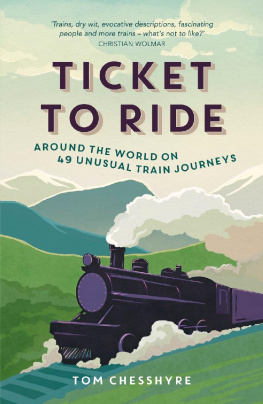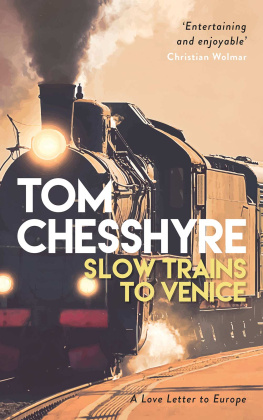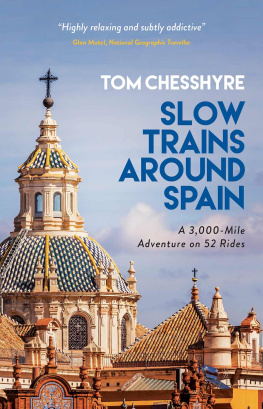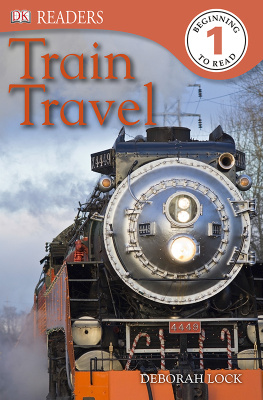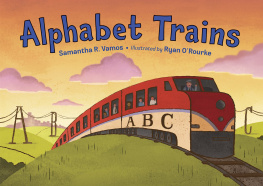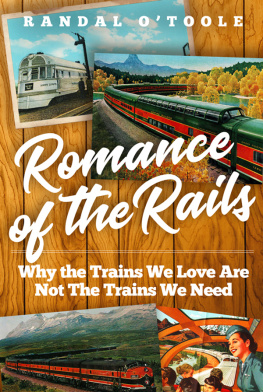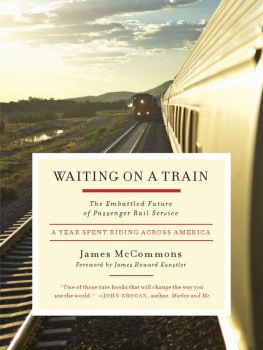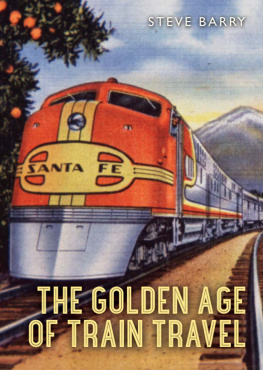PRAISE FOR TICKET TO RIDE
'Trains, dry wit, more trains, evocative descriptions, more trains, fascinating people and more trains what is there not to like?'
Christian Wolmar
'Funny and illuminating from Crewe to Korea, Ticket to Ride is a hugely entertaining account of the author's travels on the rails the world over chance encounters fly like sparks'
Sara Wheeler
'Like mini-odysseys, Chesshyre's railway journeys are by turns gentle and awesome, and full of surprises'
John Gimlette
'Tom's ticket certainly scores all the best rides: fast rides and slow ones, short trips and long ones. But most important are the names: why would any trainspotter (let alone a gricer) pass up the Reunification Express or, even better the Orient Express, for a mere airplane?'
Tony Wheeler
PRAISE FOR TALES FROM THE FAST TRAINS
'Compulsory reading'
Mark Smith, THE MAN IN SEAT 61
'Great fun, and an exhilarating read'
Sara Wheeler
'If you've "done" Paris and Bruges and are wondering, "Where next?", then this may be a quiet revelation'
Andrew Marr
'Splendid twenty-first-century railway adventure. At last this IS the age of the train'
Simon Calder, THE INDEPENDENT
'Chesshyre is an interesting, knowledgeable, discerning tour guide and a most genial companion'
Alexander Frater, author of Tales from the Torrid Zone
'Transforms seemingly unsurprising familiar territory whether the Eurostar terminal at St Pancras or the cities of Frankfurt and Antwerp into the stage for insights and adventures'
Dea Birkett, author of Serpent in Paradise
PRAISE FOR TO HULL AND BACK
'Tom Chesshyre celebrates the UK discovering pleasure in the unregarded wonders of the "unfashionable underbelly" of Britain. The moral, of course, is that heaven is where you find it'
THE MAIL ON SUNDAY
'You warm to Chesshyre, whose cultural references intelligently inform his postcards from locations less travelled'
THE TIMES
PRAISE FOR HOW LOW CAN YOU GO?
'Highly readable Bill Bryson-esque travel writing'
Clover Stroud, THE SUNDAY TELEGRAPH
'A hilarious record of a low-cost odyssey around the least salubrious corners of Europe'
Celia Brayfield, THE TIMES
PRAISE FOR A TOURIST IN THE ARAB SPRING
'This witty, perceptive book provides a fascinating read for lovers of thoughtful, imaginative and well-written travel literature'
Frank Barrett, THE MAIL ON SUNDAY
'A charming travel companion, entertaining and engaging'
TIMES LITERARY SUPPLEMENT
TICKET TO RIDE
Copyright Tom Chesshyre, 2016
All rights reserved.
No part of this book may be reproduced by any means, nor transmitted, nor translated into a machine language, without the written permission of the publishers.
Tom Chesshyre has asserted his right to be identified as the author of this work in accordance with sections 77 and 78 of the Copyright, Designs and Patents Act 1988.
Condition of Sale
This book is sold subject to the condition that it shall not, by way of trade or otherwise, be lent, resold, hired out or otherwise circulated in any form of binding or cover other than that in which it is published and without a similar condition including this condition being imposed on the subsequent purchaser.
Summersdale Publishers Ltd
46 West Street
Chichester
West Sussex
PO19 1RP
UK
www.summersdale.com
eISBN: 978-1-78372-811-4
Substantial discounts on bulk quantities of Summersdale books are available to corporations, professional associations and other organisations. For details contact Nicky Douglas by telephone: +44 (0) 1243 756902, fax: +44 (0) 1243 786300 or email: .
For all train lovers
ABOUT THE AUTHOR
Tom Chesshyre 's train travels include an 11,000-mile journey around Europe for his book on the European high-speed train revolution, and thousands of miles more across the UK for his weekly hotel column in The Times. He lives in London, and has visited almost 100 countries for his writing.
Tom is the author of How Low Can You Go?: Round Europe for 1p Each Way (Plus Tax), To Hull and Back: On Holiday in Unsung Britain, Tales from the Fast Trains: Europe at 186 mph, A Tourist in the Arab Spring and Gatecrashing Paradise: Misadventures in the Real Maldives.
www.tomchesshyre.co.uk
AUSTRALIA: MUTINY ON THE INDIAN PACIFIC
IT'S A SUN-DRENCHED morning at East Perth terminal and the Indian Pacific gleams brightly beyond the long, cool shadows of the station. Two dozen stainless steel carriages stretch along the slowly bending, boomerang-shaped platform. Light plays on ridges of steel and the indented old panels of the crosscontinental train.
Little rectangles of metal riveted by doorways explain that our coaches date from the late 1960s and early 1970s. They were built in New South Wales by Commonwealth Engineering which, it is explained, received a licence for the sleek bullet-like design from Budd, a metal fabricating company based in Philadelphia. The oldest carriage I can find is from 1967.
I've long ago learnt to seek out such details. Checking them out has almost become second nature. How old is this train? Where does it come from? How fast can this thing go? These, and other such queries, are the nuts and bolts of rail enthusiasm and as easy as it may be to mock having an interest in these 'train facts', as I might have in the past, they do somehow add to the sense of journey.
Call me a trainspotter, if you like, though I don't think I've reached that stage quite yet.
Luckily, John Brinkley, one of three train managers for this Indian Pacific service so named as it travels from the Indian Ocean to the Pacific Ocean is on hand to answer questions. He's a rotund man with a twinkle in his eyes, and looks as though he could have been a decent rugby prop forward in his day. He's welcoming guests on the platform and pointing them towards their correct carriages, and class of travel, for our three-night journey to Sydney. We are departing on a Sunday at 11:55, arriving on the east coast in four days' time, where we will pull into Sydney Central station on Wednesday at 11:07.
Those are the basics, but Brinkley goes on to say that the locomotive is an NR-19 with 4,000 horsepower, a top speed of 115 kmph and an average speed of 89 kmph. The journey will take about 65 hours with five scheduled stops, during which water and supplies are to be taken on and brief local tours are arranged for passengers. As well as the 24 carriages and locomotive, there are two 'power vans' (to give the loco a boost when required), a luggage van, and three motor-rail trailers carrying cars at the back. This train has three classes: platinum (extremely well appointed, with double beds and a swanky dining carriage with a free cocktail bar), gold (sleeper cabins and a lounge with free booze, plus free meals in a smart dining carriage), and red (the lowest class, effectively 'economy', with reclining seats and a cafe where you have to pay). I am travelling in gold for two nights followed by a night in red. The train is precisely 567 metres long and weighs 1,087.3 tonnes. Brinkley tells me that the carriages have a 'ribbed, late art deco' style.

